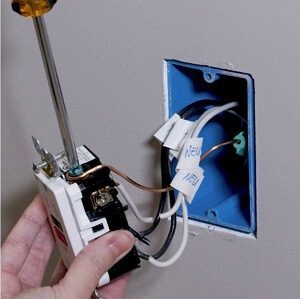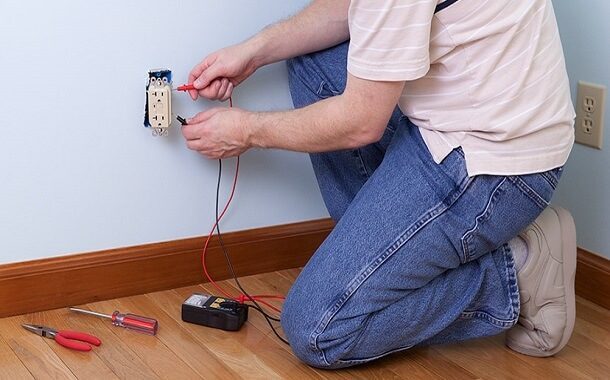GFCI Outlet Installation Cost
Last Updated on November 10, 2021
Written by CPA Alec Pow | Content Reviewed by ![]() CFA Alexander Popinker
CFA Alexander Popinker
In almost every home where an outlet is close to a water source, you will usually find what is called a grounded power switch (GFCI). This protects you against electric shocks and is an excellent option for kitchens or bathrooms.
Such a device is extremely sensitive and monitors the current flowing through it. If there is a slight change in the current flowing back from the equipment connected to the outlet, the outlet will automatically disconnect the circuit so that the electric current no longer flows.
GFCI outlets should be installed wherever there is a possibility of water coming into contact with the electrical system. This means places such as the kitchen, bathroom, water heater, oven, even outside your home.
How much does it cost to install a GFCI Outlet?
The costs of installing or replacing a GFCI outlet are the same as the ones for a standard outlet, except for the price of the part itself.
However, the final price you will pay for installing or replacing a new GFCI outlet depends on the scope of the job (new install vs. replacement), the contractor you are going to hire to do this job, where are you living, and the extra repairs that might be needed during the installation process. According to Mehdi Heidarian from Armor Electric, if the receptacle box has a proper ground conductor, the standard receptacle can be replaced by a GFCI outlet. Though, in order to ensure the home’s safety, a reliable source of ground will be installed at the receptacle box.
Installing a GFCI outlet is as easy and straightforward as installing any other type of standard 120V outlet. The average contractor charges $60 to $110 per hour, with a $110 to more than $160 minimum required to complete the service. An experienced electrician can install 10 outlets in less than an hour with a simple swap. On the other hand, if wiring is needed for a brand new installation it would take longer than an hour.
The price of a GFCI outlet is anywhere between $12 and more than $25 and the costs to install one is anywhere between $130 and $155, bringing the total cost to around $140 to $185 per outlet for both labor and part itself. However, if there will be the need to install more than one outlet in a day, then you better add around $30 per outlet because often the contractors charge more for just one outlet due to the minimum job fee.
The costs of a new outlet location will depend on how much wiring is needed and the location of the breaker, but for the majority of the jobs be prepared to pay anywhere between $180 and $290.
We recommend that you look for at least free price estimates before deciding which contractor to hire as this job is quite unique.
GFCI Outlet Installation details
 The installation of GFCI outlets and any electrical appliance is recommended to be performed by a specialized person (authorized electricians).
The installation of GFCI outlets and any electrical appliance is recommended to be performed by a specialized person (authorized electricians).
To connect an electrical appliance (outlet) to the electrical circuit, it is mandatory to disconnect the respective circuit from the electrical network in order to prevent accidental electric shock.
To connect an outlet to the electrical circuit, the ends of the electrical conductors are stripped 10-15mm and connected to the outlet terminals. Keep in mind that the ground circuit must be connected to the ground terminals of the outlet.
What are the extra costs?
Rewiring: If there is a bad working GFCI outlet, then it can cause damage to the whole wiring. Depending on the necessary amount of wiring and on how much it takes to replace it, the costs could increase by anywhere from $520 to a few thousand dollars.
You might also like our articles about the cost of GenerLink, metal framing, or a new garage.
Service panel replacement: As with the wiring, the service panel can be faulty in some situations, which usually would add $1,100 to more than $2,200 to your final project. The same goes for homeowners who also want to upgrade their service panels. Sometimes this is the main cause of a bad working GFCI outlet.
Moving an outlet: If you are not satisfied with the actual location of the outlet, it can be moved to another place by an electrician. Depending on how far this has to be moved it would cost $30 to more than $260. The materials used for construction will often be the biggest factor in determining how much it costs to have an electrician come and do the job. If drywall is being installed, then tearing through old walls and reaching behind them may require more time-consuming work than if you’re replacing it with beams exposed.
GFCI Requirements
Garage: there will be at least one receptacle necessary, with one for every car space. Protection is required for all receptacles.
Bathrooms: a 20-amp circuit is required for all outlets and GFCI protection as well.
Laundry room: any gas dryer/shared washer receptacle needs at least one 20-amp circuit. A separate 30-amp and 340-volt circuit wired with four conducts is needed for an electric dryer. Also, GFCI protection is needed for all receptacles in the laundry room.
Kitchen: in order to serve the countertop receptacles at least two 20-amp small appliance circuits will be necessary. GFCI protection is needed for all outlets six feet one from another.
Good to know
GFCI outlets are very important for protecting against the electrocution of both adults and children, as well as pets. It is recommended to use GFCI outlets for all the powerful electronics and appliances. It is good to use GFCI outlets for the computer as well because, in case of voltage drops, the GFCI outlet will reduce the possibility of burning the source.


Leave a Reply
Want to join the discussion?Feel free to contribute!